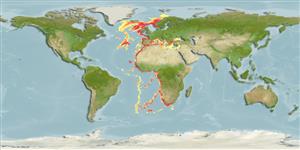Élasmobranches (requins et raies) (sharks and rays) >
Squaliformes (Sleeper and dogfish sharks) >
Etmopteridae (Lantern sharks)
Etymology: Etmopterus: Greek, ethmos, -ou = sieve or ethmoides bone + Greek, pteron = wing, fin (Ref. 45335).
More on author: Linnaeus.
Environment: milieu / climate zone / depth range / distribution range
Écologie
marin bathydémersal; profondeur 70 - 2490 m (Ref. 106604), usually 200 - 500 m (Ref. 128537). Deep-water; 73°N - 38°S, 40°W - 36°E
Eastern Atlantic: Iceland, Norway, and the western Mediterranean to Morocco, Senegal, Sierra Leone, Côte d'Ivoire to Nigeria, Cameroon to Gabon, Azores, Cape Verde, and Cape Province, South Africa (Ref. 247).
Length at first maturity / Taille / Poids / Âge
Maturity: Lm 34.5, range 33 - 36 cm
Max length : 60.0 cm TL mâle / non sexé; (Ref. 247); common length : 45.0 cm TL mâle / non sexé; (Ref. 247); poids max. publié: 850.00 g (Ref. 40637)
Found on the outer continental shelves and upper slopes. Feeds on small fishes, squids, and crustaceans. Ovoviviparous, with number of young from 6 to 20 in a litter. Utilized for fishmeal and prepared dried salted for human consumption. Depth range reported at 70m-2000m in Ref. 35388.
Distinct pairing with embrace (Ref. 205).
Compagno, L.J.V., 1984. FAO Species Catalogue. Vol. 4. Sharks of the world. An annotated and illustrated catalogue of shark species known to date. Part 1 - Hexanchiformes to Lamniformes. FAO Fish. Synop. 125(4/1):1-249. Rome, FAO. (Ref. 247)
Statut dans la liste rouge de l'IUCN (Ref. 130435)
Menace pour l'homme
Harmless
Utilisations par l'homme
Pêcheries: intérêt commercial mineur
Outils
Articles particuliers
Télécharger en XML
Sources Internet
Estimates based on models
Preferred temperature (Ref.
123201): 5.8 - 14.2, mean 9.2 °C (based on 392 cells).
Phylogenetic diversity index (Ref.
82804): PD
50 = 0.5000 [Uniqueness, from 0.5 = low to 2.0 = high].
Bayesian length-weight: a=0.00339 (0.00284 - 0.00404), b=3.06 (3.01 - 3.11), in cm total length, based on LWR estimates for this species (Ref.
93245).
Niveau trophique (Ref.
69278): 4.1 ±0.2 se; based on diet studies.
Generation time: 6.9 ( na - na) years. Estimated as median ln(3)/K based on 2
growth studies.
Résilience (Ref.
120179): Très faible, temps minimum de doublement de population supérieur à 14 ans (Fec=6).
Fishing Vulnerability (Ref.
59153): High vulnerability (63 of 100).
Climate Vulnerability (Ref.
125649): Low vulnerability (13 of 100).
Nutrients (Ref.
124155): Calcium = 9.76 [1.96, 51.89] mg/100g; Iron = 0.36 [0.08, 1.19] mg/100g; Protein = 19.3 [16.7, 21.6] %; Omega3 = 0.351 [0.129, 1.142] g/100g; Selenium = 16 [5, 48] μg/100g; VitaminA = 15.4 [3.4, 70.8] μg/100g; Zinc = 0.312 [0.149, 0.618] mg/100g (wet weight);
